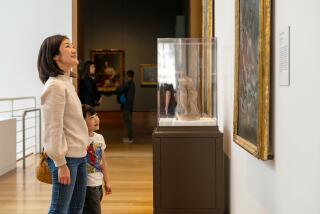Outcry as Los Angeles County Museum of Art raises patron fees
The price of behind-the-scenes access at the Los Angeles County Museum of Art is going up. And some donors in the museum’s oldest support groups are talking about dropping out.
The changes affect the long-standing art councils at LACMA, groups of art enthusiasts and professionals who currently pay a minimum of $400 a year in dues and organize projects to raise money for a favorite department, such as photography or decorative arts. The perks include access to private events featuring artists, curators or collectors.
This week, in the biggest overhaul of the system in decades, museum director Michael Govan announced that he was raising dues for members of all 10 councils to $1,000, which does not include a $250-level museum membership they must now purchase each year.
PHOTOS: Arts and culture in photos by The Times
Govan said the fee increase was long overdue. “This change will bring us more in line with other museums nationally,” he said, citing higher dues at other museums in Los Angeles, Boston and New York. “To have an affinity group that has direct access to curators and artists, even at the new number, you could call it a bargain.”
But several council members are calling it the opposite. Screenwriter Gloria Katz Huyck (“American Graffiti” and “Indiana Jones and the Temple of Doom”), who is chair of the 141-member photo council, described what amounts to a tripling of fees as “unconscionable” and “extremely short-sighted.”
“Obviously, they are going after the big donors, and there will be no place for the small donor to participate any more,” she said. “What it spells to us is elitism.”
She noted that the photography council raised more than $100,000 last year and that members contributed artworks as well as enthusiasm and expertise. (She and her husband recently gave 250 vintage Indian photographs to the museum.)
“What they don’t realize is that sometimes people of modest means have great collections,” she said. “There are a lot of people on the council who bought major pieces in the 1960s or ‘70s, which they will now either sell or donate to the Getty.”
Huyck said her group is discussing the possibility of legally separating from LACMA or supporting another local museum.
Cindy Canzoneri said the future of the costume council, which she chairs, is also uncertain.
“I’m afraid this will be the end of the costume council,” she said of the group that has helped finance the museum’s high-fashion acquisitions and exhibitions for nearly 60 years, raising some $200,000 in 2011. “This is heartbreaking. The way they’ve set this up, we will lose so many members. We will lose all the people who can’t afford more than $400 and all the people who feel they aren’t being appreciated.”
Govan acknowledged that there could be a “significant” drop in membership short-term but said that he was “not worried” about the councils’ survival. “They will continue to exist,” he said.
He invited council members to a meeting Tuesday, where he described the changes as part of a larger rethinking of the role of these groups. They were instrumental in fundraising in the museum’s early years before it even had a development office. Now, he said, it was important to make the system “simpler” and “more professional.”
GRAPHIC: High earning art executives
As a nonprofit organization, he said, “we need our fundraising to be run in a more consistent manner through the development office.” He explained that it was not “best practices for a large museum these days” to allow different groups outside their reporting structure to raise and allocate funds.
The plan includes dismantling the boards of the councils, leaving only a chairperson in place to help the department curator and development staff organize events. He also described a change in what the councils would do: organizing public events instead of private parties and focusing “more on education and the sharing of enthusiasm than acquisitions.”
Currently, fundraising for acquisitions at the highest level takes place through the board of trustees. (Govan called LACMA’s endowment for acquisitions “very tiny.”) Only a few curators, like those for Japanese art and decorative arts and design, cultivate support from dedicated “acquisition groups.”
Govan wants to encourage other departments to form these acquisition groups with $5,000 to $10,000 annual membership fees.
“Everyone who wants to play a role in this museum should be able to,” said Govan.
If you have time but not money to give, he suggested, you can be a docent. “At $1,000, the primary mission is education and programming. At $5,000, it will be acquisitions,” he said.
But the price hike seemed to rankle current council members more than the change in focus. As of last week, there were roughly 1,200 council members. About two-thirds of them pay dues at the $400 level. Others contribute $1,000 or $3,000 to receive additional benefits.
GRAPHIC: High earning conductors
Mark P. Goodman, a 45-year-old physician who says he is the youngest member of the American art council, believes the new flat fee could discourage younger members from joining.
“My concern is that this price difference will close the door to a lot of young professionals who are coming of age or coming into the means to be philanthropic,” he said. “My concern is that this price point will set the bar too high.”
Other council members, though, said they respect the reasons behind the fee increase, even if they don’t like it.
Paul Kopeikin, a photography gallery owner, said: “There is no question in my mind that people on the council have to step up more financially because the times have changed, the art world has changed. $400 just does not buy what it used to.”
It is not clear how many people will withdraw their support over the fee increase, which goes into effect in January for new members and in June for existing ones.
Govan said he wants to honor longtime supporters, even if they do leave the councils.
“Say they’ve been on a council 10 years or more; they will get a free dual membership for life,” he said. “We are trying to work out other benefits to make sure other people who have donated time or money feel welcome at the museum.”
MORE
INTERACTIVE: Christopher Hawthorne’s On the Boulevards
TIMELINE: John Cage’s Los Angeles
PHOTOS: Arts and culture in pictures
More to Read
The biggest entertainment stories
Get our big stories about Hollywood, film, television, music, arts, culture and more right in your inbox as soon as they publish.
You may occasionally receive promotional content from the Los Angeles Times.






